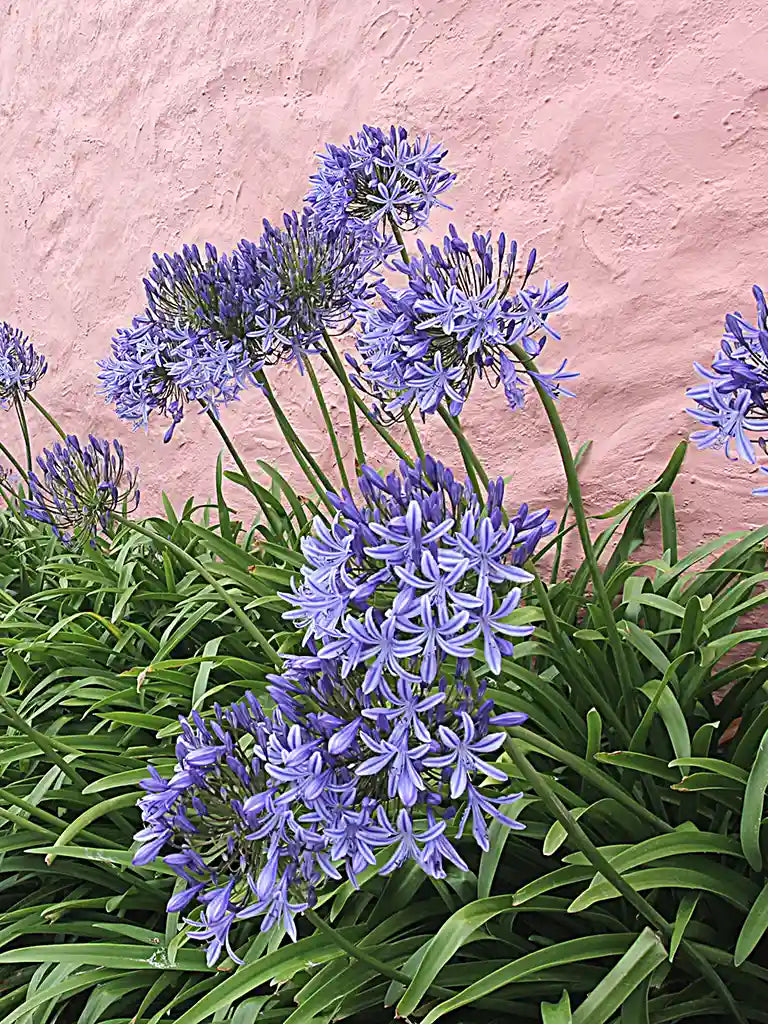Bloemoloog
Organic Agapanthus africanus 'Dr. Brouwer' - African lily
Organic Agapanthus africanus 'Dr. Brouwer' - African lily
Estimated Shipping Widget will be displayed here!
Couldn't load pickup availability
Organic African lily
The Agapanthus africanus is the queen of potted plants but also blooms beautifully in the garden. She owes her name 'love flower' to the Greek words; agape, meaning 'love' and anthos, meaning 'flower'. This forms the Greek word agapanthus. In the Netherlands it is also known as 'African lily'.
The plant forms long narrow leaves and from the heart of the plant long sturdy stems of about 75 centimeters high emerge, topped with large blue spherical flower heads. The umbels are formed by many trumpet-like flowers that contain a lot of nectar for insects. It therefore attracts many bees, butterflies and even hummingbird butterflies and blooms for a very long time in mid-summer from July to September.
The leaves of the Agapanthus africanus 'Dr. Brouwer' die off completely in winter, this cultivar is deciduous.
How, where and when do I plant an agapanthus?
Indoor pre-growth
If possible, we recommend growing the tubers indoors in a pot from March onwards. After you have planted them, give them a little water once a week, so that the plant is already a bit bigger around May 15 and therefore has a head start. Feeding can then be given immediately in March.
Outside in the garden
The tubers of the agapanthus are grown outside in the spring after May 15 in a sunny location in light, fertile soil with good drainage. A mixture of clay, sand and organic matter such as compost or well-rotted manure is ideal for agapanthus.
It is important that the soil is not too heavy or compact, as this can cause waterlogging and suffocate the roots. Agapanthus tends to grow better in slightly drier conditions than in overly wet soil.
When planting, the green leaves of the tuber remain just above the ground and it becomes most beautiful if it is planted with several tubers together in a group. You place the tubers against each other so that they form a robust root ball.
Care of the African lily
The agapanthus loves food. Give her organic fertilizer 3 times a year. Preferably during planting in March, but can also be done later if it is planted after May 15 and then fed again in July and August.
We recommend Bio Kultura for organic potting soil, plant food and other soil improvers !
The spent flowers are cut out and the leaves are left to die. The plant prefers to experience a single night frost, so that the plant can go into hibernation before it is brought indoors for the winter. In winter they prefer to hibernate in a frost-free, dry and cool place between 6 and 10 degrees Celsius and do not water them. This way you can enjoy this fantastic summer bloomer every year.
Propagation
Tip: Divide the root ball after 5 years if, for example, the pot grows too full. Don't do it every year because the agapanthus prefers to be left alone. If you divide the root ball, it is important that 1/3 of the bottom is also removed. This way the plant stays young and can continue to expand underground.
Origin
The agapanthus comes from South Africa and belongs to the Liliaceae family.
Buy Organic Agapanthus 'Dr. Brouwer'
Skal NL-BIO-01 certified: 109459
Individually packaged or choose a stacking discount.
Stacking discount: A
Delivery within 5 working days!
EU shipping €8.95 - Free shipping from €100 purchase.
Note: you are purchasing bare roots!
Characteristics
| Flowering time: | July - September |
| Planting time: |
From May (or from March indoors) |
| Planting depth: |
Green leaves above the ground |
| Planting distance: | Max 15 per m² |
| Height: |
75 cm high |
| Flower diameter: | 15 cm wide |
| Location: |
Sun |
| Soil PH: | Loam, sandy soil - Slightly acidic/neutral |
| Winter hardiness: |
Moderately hardy (cover) |
| Deciduous: |
Yes |
| Propagation: | Good |
| Family: | Liliaceae (lily family) |
| Colour: | Blue |
| Bee-friendly: | Yes |
| Fragrant: | No |
| Quality: | L (3 noses) |

NL-BIO-01
To share












